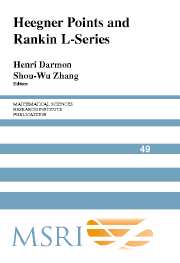Introduction
Let E be an elliptic curve over Q of conductor N. By the fundamental work initiated in [Wi] and brought to a successful conclusion in [BCDT], the curve E is equipped with a nonconstant complex uniformisation
where H is the Poincaré upper half-plane and Γ0(N) is Hecke's congruence group of level N.
Fix a quadratic field K; when it is imaginary, the theory of complex multiplication combined with (0–1) yields the construction of a remarkable collection of points on E defined over certain ring class fields of K. These are the Heegner points recalled in Section 1 whose study is one of the themes of this proceedings volume.
When p is a prime that divides N exactly, and E a factor of the Jacobian of a Shimura curve attached to a quaternion algebra ramified at p, the uniformisation Φ of (0–1) admits a p-adic analogue based on theorems of Jacquet–Langlands and Cerednik–Drinfeld, in which H is replaced by Drinfeld's p-adic upper half plane , and Γ0(N) by an appropriate ﹛p﹜-arithmetic subgroup of a definite quaternion algebra over Q. This somewhat less well-known theory is recalled in Section 2, where a p-adic variant of the complex Heegner point construction of Section 1 is described.
Retaining the assumption that N = pM with , Section 3 introduces the ﹛p﹜-arithmetic group Γ ⊂ SL2(Q) defined by
This group acts both on H and on Hp by Möbius transformations, and the diagonal action of Γ on Hp ×H is discrete. A double integral on (Hp ×H)/Γ is defined to be a C or Cp-valued function of (τ1, τ2, τ3, τ4) ∊ H2p ×H2, denoted
satisfying the obvious additivity properties suggested by the notation, as well as being invariant under the diagonal action of Γ. The normalised eigenform f of weight 2 attached to E is shown in Section 3 to give rise in a natural way to a C-valued double integral on (Hp ×H)/Γ. This function can be viewed as encoding the complex periods of a “form ω of weight (2, 2)” on (Hp × H)/Γ attached to E.
 $p$-ADIC ITERATED INTEGRALS ATTACHED TO MODULAR FORMS OF WEIGHT ONE
$p$-ADIC ITERATED INTEGRALS ATTACHED TO MODULAR FORMS OF WEIGHT ONE
